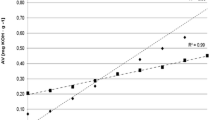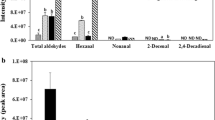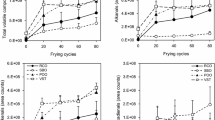Summary
Sets of 500 g of potatoes were fried discontinuously 15 times in 3 1 of sunflower oil without addition of unused oil. The fat content of fried potatoes increased with the number of fryings. The quality of the extracted oil from the fried potatoes was evaluated by a combination of column and high performance size exclusion chromatography, and compared with their respective fryer oils. Total polar content (mg 100 mg oil−1) increased after 15 fryings from 6.2±0.35 to 18.7±0.81 in the oil in the frier and to 21.2±0.92 in the fries. Triglyceride polymers, triglyceride dimers and oxidized triglycerides (mg 100 mg oil−1) increased progressively and significantly with the number of fryings either in the fryer oil or in the extracted oil, being the content of triglyceride dimers significantly higher in the extracted oil than in the oil in the fryer. Potatoes from the 15th frying contained more total alteration-oil-products, triglyceride polymers, triglyceride dimers and oxidized triglycerides (g 100 g fresh matter−1) than potatoes from the 8th frying (allp<0.01). This fact may be of special relevance for some people who usually eat large quantities of potatoes fried in oils with a null or low turnover of fresh oil.
Zusammenfassung
In 3 1 Sonnenblumenöl wurden 15 mal aufeinanderfolgend je 500 g Kartoffeln, ohne zusätzliche Beigabe von ungebrauchtem Öl, fritiert. Der Ölgehalt der fritierten Kartoffeln nahm bei jedem Fritieren zu. Die Qualität des aus den fritierten Kartoffeln extrahierten Öls wurde durch eine Kombination von Säulenchromatographie und high performance size exclusion chromatography bestimmt, und mit den betreffenden Fritierölen verglichen. Der Gehalt polarer Fettbestandteile (mg/100 mg Öl) stieg nach 15 Fritierungen von 6,2±0,35 auf 18,7±0,8 in dem Fritieröl und auf 21,2±0,92 in dem Fritiergut. Polymere, dimere und oxydierte Triglyceride (mg/100 mg Öl) nahmen stufenweise und signifikant mit der Anzahl von Fritierungen zu, sowohl in dem Öl als auch in dem aus den Kartoffeln extrahierten Fritieröl. Der Inhalt an Triglyceriddimeren war bedeutend höher in dem extrahierten Öl als in dem Fritieröl. Kartoffeln, die zum 15. Mal fritiert wurden, wiesen eine höhere Konzentration an gesamten Zersetzungsprodukten, Polymeren, Dimeren und oxydierten Triglyceriden (mg/100 mg frische Materie) auf als Kartoffeln, die zum 8. Mal fritiert wurden (allesp<0,01). Diese Tatsache kann vor allem für die Leute wichtig sein, die normalerweise große Mengen von fritierten Kartoffeln essen, die in einem Öl gebraten wurden, zu dem keine oder nur kleine Mengen frisches Öl zugegeben worden waren.
Similar content being viewed by others
References
Arroyo R, Cuesta C, Garrido-Polonio C, López-Varela S, Sánchez-Muniz FJ (1992) J Am Oil Chem Soc 69:557–563
Blumenthal MM (1991) Food Technol 45:68–71
Christopoulou CN, Perkins EG (1989) J Am Oil Chem Sco 66:1338–1343
Combe N, Constantin MJ, Entressangles B (1981) Lipids 16:8–14
Cuesta C, Sánchez-Muniz FJ, Varela G (1988) Varela G, Bender AE, Morton ID (eds) Frying of food. Principles, changes, new approaches. Ellis Horwood Ltd, Chichester (UK), pp 112–128
Cuesta C, Sánchez-Muniz FJ, Garrido-Polonio C, López-Varela S, Arroyo R (1993) J Am Oil Chem Soc 70:1069–1073
Dobarganes MC, Pérez-Camino MC, Gutiérrez González-Quijano R (1984) Grasas y Aceites 35:172–177
Dobarganes MC, Pérez-Camino MC, Márquez-Ruiz G (1988) Fat Sci Technol 90:308–311
Gere A (1982) Z Ernährungswiss 21:191–201
Greenfield M, Makinson J, Wills RBH (1984) J Food Technol 19:239–245
Guillaumin R (1988) Varela G, Bender AE, Morton ID (eds) Frying of food. Principles, changes, new approaches. Ellis Horwood Ltd, Chichester (UK), pp 82–90
Gutiérrez González-Quijano R, Dobarganes MC (1988) Varela G, Bender AE, Morton ID (eds) Frying of food. Principles, changes, new approaches. Ellis Horwood Ltd, Chichester (UK), pp 141–154
Márquez-Ruiz G (1990) Evaluación analítica y nutricional de grasas comestibles termoxidadas. Ph.D Thesis. Universidad de Sevilla, Sevilla
Meltzer JB, Frankel EN, Bessler TR, Perkins EG (1981) J Am Oil Chem Soc 58:779–784
Moreiras-Tuni O, Carbajal A, Pérez del Pino IM (1990) Ministerio de Sanidad y Consumo. Secretaría General Técnica (ed) Evolución de los hábitos alimentarios en España. Artes Gráficas Iberoamericanas, S.A. Madrid, pp 103–108
Nolen GA (1973) J Nutr 103:1248–1255
Peers KE, Swoboda PAT (1982) J Sci Food Agric 33:389–395
Pérez-Camino MC, Márquez-Ruiz G, Ruiz-Méndez MV, Dobarganes MC (1991) J Food Sci 56:1644–1650
Pinthus EJ, Weinberg P, Saguy IS (1992) J Food Sci 57:1359–1360
Pokorny J (1980) Riv Ital Sostanze Grasse 57:222–225
Ribot E, Astorg PO, Blanchard F, Chonkroun M, François-Collange F, Grandgirard A, Guillaumin R, Karlesknd M, Morin O, Rugraff L, Sebedio JL, Veretout O (1989) Etat d'alteration de bains de friture prélevés dans les ménages français. Proceedings, International Chevreul Congress, Angers, France, June 6–9, ATECG; Paris, pp 326–333
Sánchez-Muniz FJ, Hernández I, Cuesta C (1989) Grasas y Aceites 40:399–405
Sánchez-Muniz FJ, Viejo JM, Medina R (1992) J Agric Food Chem 40:2252–2256
Sánchez-Muniz FJ, Cuesta C, Garrido-Polonio MC (1994) Z Ernährungswiss 33:16–23
Sebedio JL, Bonpunt A, Grandgirard A, Prevost J (1990) J Agric Food Chem 38:1862–1867
Selman JD, Hopkins M (1989) Factors affecting oil uptake during the production of fried potato products. Tech Memorandum 475. Campden Food and Drink Res Assoc Chipping Campden, Gloucestershire (UK)
Tracy L, Guftafson MD (1987) The Epistat. Epistat Service.
Varela G (1977) Biblthca Nutr Dieta 25:112–121
Varela G, Moreiras-Varela O, Ruiz-Roso B (1983) Grasas y Aceites 34:101–107
Varela G (1988) Current facts about the fryings of food. Varela G, Bender AE, Morton ID (eds) Frying of food. Principles, changes, new approaches. Ellis Horwood Ltd, Chichester (UK), pp 9–25
Waltking AE, Wessels H (1981) J Assoc Off Anal Chem 64:1329–1330
Author information
Authors and Affiliations
Rights and permissions
About this article
Cite this article
Garrido-Polonio, M.C., Sánchez-Muniz, F.J., Arroyo, R. et al. Small scale frying of potatoes in sunflower oil: thermoxidative alteration of the fat content in the fried product. Z Ernährungswiss 33, 267–276 (1994). https://doi.org/10.1007/BF01614432
Received:
Accepted:
Published:
Issue Date:
DOI: https://doi.org/10.1007/BF01614432
Key words
- Column chromatography
- size-exclusion chromatography
- polar fraction
- deepfat frying
- fat composition
- fried potatoes
- sunflower oil




